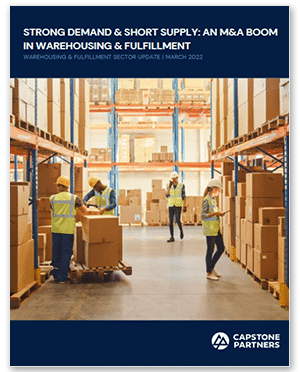Warehousing & Fulfillment Market Update
Strong Demand and Short Supply Causes M&A Boom in Warehousing & Fulfillment
Capstone Partners released its March 2022 Warehousing & Fulfillment Sector Update, reporting that the market is booming as a result of supply chain disruptions in the past year with record revenue growth and earnings per share (EPS), leading to rapid expansion and acquisition activity.
E-Commerce Fulfillment Providers Benefit from Supply Chain Demand
The merger and acquisition (M&A) environment is hot in the Warehousing & Fulfillment sector as retailers and logistics companies look to increase control over their end-to-end supply chain. With the acceleration of online shopping, most of the notable deals have occurred in the E-commerce Fulfillment space, versus Industrial & Business-to-Business (B2B) Warehousing. Traditional retailers, not just logistics companies, have made a big splash in the M&A market, causing heightened acquirer demand and pushing valuations higher. In a prime example, Quiet Logistics, a rapidly growing third-party logistics provider with a focus on e-commerce, was acquired by American Eagle Outfitters (NYSE:AEO) in December 2021 for a total enterprise value of $360 million. Quiet Logistics will join American Eagle as their second logistics acquisition of 2021, soon after its acquisition of AirTerra in August 2021 (undisclosed). These acquisitions demonstrate how retailers are leveraging logistics as a strategic tool and will allow American Eagle to reduce costs and generate efficiencies.
FedEx (NYSE:FDX) and UPS (NYSE:UPS) dominate the U.S. Parcel Delivery market. However, as a result of the pandemic-induced surge in package volume flooding their networks, shippers have encountered surcharges, service issues, increased rates, and capacity constraints. In response, shippers are diversifying their volume by relying on more regional carriers and third-party transportation managers, instead of sticking exclusively with FedEx or UPS. Shipware, a developer of freight audit software and consulting services, estimated that 70% of its clients are looking into using regional carriers, up from 25% two years ago. To alleviate this stress on shippers, smaller and regional carriers are banding together to build their own national transportation company.
Also included in Warehousing & Fulfillment Market report:
- Case studies on recent acquisitions that are re-shaping the Warehousing & Fulfillment industry
- The resulting impact on parcel strategies
- A detailed analysis on how traditional logistics transportation providers and consumer retailers are expanding further into Warehousing & Fulfillment in order to offer more services and protect in-house supply chains
Related Transactions
Insights for Middle Market Leaders
Receive email updates with our proprietary data, reports, and insights as they’re published for the industries that matter to you most.









